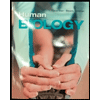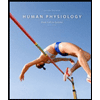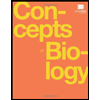
LAB MANUAL TO ACCOMPANY FD A+P CONNECT
4th Edition
ISBN: 9781307898811
Author: McKinley
Publisher: MCG
expand_more
expand_more
format_list_bulleted
Textbook Question
Chapter 23.5, Problem 22WDYL
How are larger amounts of air moved between the lungs and atmosphere during forced inspiration and forced expiration? Is more energy expended during forced breathing? Why?
Expert Solution & Answer
Want to see the full answer?
Check out a sample textbook solution
Students have asked these similar questions
Despite two individuals having high BMI with similar values, one person is more susceptible to cardiovascular disease than the other. This persons's obesity is known as
Group of answer choices
genetic obesity
dietary obesity
android obesity
gynoid obesity
It is generally believed that earlier adaptation to cold would affect survival in hypoxia. This effect is known as-
Group of answer choices
habituation
negative acclimatization
positive acclimation
accommodation
How is convection altered in a hot sauna room? What would be the net heat exchange? Use appropriate formula to explain.
Chapter 23 Solutions
LAB MANUAL TO ACCOMPANY FD A+P CONNECT
Ch. 23.1 - Which respiratory structure is associated with the...Ch. 23.1 - Prob. 2WDYLCh. 23.1 - In what ways does the epithelium of the upper...Ch. 23.2 - What changes occur to inhaled air as it passes...Ch. 23.2 - Prob. 5WDYLCh. 23.2 - What two regions of the pharynx contain tonsils?...Ch. 23.2 - How does the larynx assist in increasing abdominal...Ch. 23.2 - What are the three unpaired cartilages in the...Ch. 23.2 - Prob. 9WDYLCh. 23.3 - What is the function of the C-shaped tracheal...
Ch. 23.3 - What are the significant structural differences...Ch. 23.3 - Which of the following respiratory structures are...Ch. 23.3 - The respiratory tract can be damaged from...Ch. 23.3 - Prob. 14WDYLCh. 23.3 - Prob. 15WDYLCh. 23.4 - Match the component of the ling with its air...Ch. 23.4 - Prob. 17WDYLCh. 23.4 - What is the function of serous fluid within the...Ch. 23.4 - Why is the intrapleural pressure normally lower...Ch. 23.5 - Prob. 20WDYLCh. 23.5 - Describe the sequence of events of quiet...Ch. 23.5 - How are larger amounts of air moved between the...Ch. 23.5 - Prob. 23WDYLCh. 23.5 - Which of the following stimuli will cause an...Ch. 23.5 - Are the skeletal muscles of breathing innervated...Ch. 23.5 - The two factors that determine airflow are the...Ch. 23.5 - A person in yoga class is encouraged to take long,...Ch. 23.5 - Prob. 28WDYLCh. 23.6 - Given the same partial pressure for oxygen and...Ch. 23.6 - How do the partial pressures of oxygen and carbon...Ch. 23.6 - Prob. 31WDYLCh. 23.6 - How do the partial pressures of oxygen and carbon...Ch. 23.7 - Why is such a small percentage (about 2%) of...Ch. 23.7 - How is the majority of carbon dioxide transported...Ch. 23.7 - How does oxygen movement occur during alveolar gas...Ch. 23.7 - How does carbon dioxide movement occur during...Ch. 23.7 - Does hemoglobin saturation increase or decrease...Ch. 23.7 - How is oxygen release from hemoglobin during...Ch. 23.8 - How does blood PO2 and PCO2 change if an...Ch. 23.8 - How does blood PO2 and PCO2 change during...Ch. 23.8 - Prob. 41WDYLCh. 23 - Prob. 1DYKBCh. 23 - Prob. 2DYKBCh. 23 - Prob. 3DYKBCh. 23 - Prob. 4DYKBCh. 23 - Prob. 5DYKBCh. 23 - Which areas of the brain contain the respiratory...Ch. 23 - Prob. 7DYKBCh. 23 - Prob. 8DYKBCh. 23 - Prob. 9DYKBCh. 23 - Prob. 10DYKBCh. 23 - Explain how the respiratory tract is organized...Ch. 23 - Describe the relationship of the visceral pleura,...Ch. 23 - List the four processes of respiration, in order,...Ch. 23 - Describe the muscles, volume changes, and pressure...Ch. 23 - Explain how additional air is moved during a...Ch. 23 - Describe bow quiet breathing is controlled by the...Ch. 23 - Explain alveolar and systemic gas exchange.Ch. 23 - List the two means by which oxygen is transported...Ch. 23 - Describe the relationship of PCO2 and hemoglobin...Ch. 23 - List the variables that increase the release of...Ch. 23 - Paramedics arrived at a car accident to find an...Ch. 23 - Use the following to answer questions 24....Ch. 23 - Use the following to answer questions 24....Ch. 23 - Use the following to answer questions 24....Ch. 23 - Prob. 5CALCh. 23 - Prob. 1CSLCh. 23 - The nerve to the sternocleidomastoid muscle was...Ch. 23 - Prob. 3CSL
Knowledge Booster
Learn more about
Need a deep-dive on the concept behind this application? Look no further. Learn more about this topic, biology and related others by exploring similar questions and additional content below.Similar questions
- How have the Arctic Inuits (people living in the Arctic) been able to stay in such cold conditions for so long? List and explain your reasons.arrow_forwardRecently I saw an action movie where the kidnappers accidentally killed the business tycoon by immersing his face in ice water. What could be the cause of death in this case? Group of answer choices vasodilation of peripheral vessels restriction of limb movement cardiac arrhythmia inability to open the eyesarrow_forwardBesides lack of food, what are the other physiological conditions that exacerbate the effects of starvation in developing countries?arrow_forward
- 1. A few years back, the faculty in Biology department faced complete loss of their research labs and office space due to unexpected flooding. This was early in the morning when students had come on-campus for their classes and faculty were ready to start teaching. a. Briefly explain the pathway that would have been activated in this acute stress. b. Also, considering that it was a while before things resumed to normal, explain what the effects of chronic stress under such conditions were.arrow_forwardwhich produces such as Cellular Respiration begins with NAD+ which is broken down during, to make which produces which occurs in the in the presence of anaerobic respiration that is used in pyruvate that is used in aerobic respiration alcohol such as which produces which is used in the to make 32 ATP -which produces which occurs in the starting with which occurs in thearrow_forwardDay 3-A: Venn Diagram Directions: Using the Venn diagram, describe a pure substance using the properties of elements and compounds. Write only the letters corresponding to your responses. PURE SUBSTANCE ELEMENTS COMPOUNDS A. It is the simplest form of matter.. B. It cannot be separated into simpler components by chemical means. C. It is made by two or more elements combined. D. It serves as the building block of other substances. E. Examples are oxygen, hydrogen, carbon, and gold. F. It can be separated into simpler substances by chemical means. G. It is represented by a chemical formula. H. Examples are water, sugar, salt, and baking soda. 3arrow_forward
- Describe in details the two molecular processes in steroid and peptide actionarrow_forwardCan you choose one topic of interest associated with microbiology, human diseases and / or human health.arrow_forwardPatients identified as at risk for falling are the most likely to suffer an Unanticipated Physiological fallarrow_forward
arrow_back_ios
SEE MORE QUESTIONS
arrow_forward_ios
Recommended textbooks for you
 Human Biology (MindTap Course List)BiologyISBN:9781305112100Author:Cecie Starr, Beverly McMillanPublisher:Cengage Learning
Human Biology (MindTap Course List)BiologyISBN:9781305112100Author:Cecie Starr, Beverly McMillanPublisher:Cengage Learning Human Physiology: From Cells to Systems (MindTap ...BiologyISBN:9781285866932Author:Lauralee SherwoodPublisher:Cengage Learning
Human Physiology: From Cells to Systems (MindTap ...BiologyISBN:9781285866932Author:Lauralee SherwoodPublisher:Cengage Learning Biology (MindTap Course List)BiologyISBN:9781337392938Author:Eldra Solomon, Charles Martin, Diana W. Martin, Linda R. BergPublisher:Cengage Learning
Biology (MindTap Course List)BiologyISBN:9781337392938Author:Eldra Solomon, Charles Martin, Diana W. Martin, Linda R. BergPublisher:Cengage Learning Concepts of BiologyBiologyISBN:9781938168116Author:Samantha Fowler, Rebecca Roush, James WisePublisher:OpenStax CollegeBasic Clinical Lab Competencies for Respiratory C...NursingISBN:9781285244662Author:WhitePublisher:Cengage
Concepts of BiologyBiologyISBN:9781938168116Author:Samantha Fowler, Rebecca Roush, James WisePublisher:OpenStax CollegeBasic Clinical Lab Competencies for Respiratory C...NursingISBN:9781285244662Author:WhitePublisher:Cengage

Human Biology (MindTap Course List)
Biology
ISBN:9781305112100
Author:Cecie Starr, Beverly McMillan
Publisher:Cengage Learning

Human Physiology: From Cells to Systems (MindTap ...
Biology
ISBN:9781285866932
Author:Lauralee Sherwood
Publisher:Cengage Learning

Biology (MindTap Course List)
Biology
ISBN:9781337392938
Author:Eldra Solomon, Charles Martin, Diana W. Martin, Linda R. Berg
Publisher:Cengage Learning

Concepts of Biology
Biology
ISBN:9781938168116
Author:Samantha Fowler, Rebecca Roush, James Wise
Publisher:OpenStax College


Basic Clinical Lab Competencies for Respiratory C...
Nursing
ISBN:9781285244662
Author:White
Publisher:Cengage
Respiratory System; Author: Amoeba Sisters;https://www.youtube.com/watch?v=v_j-LD2YEqg;License: Standard youtube license